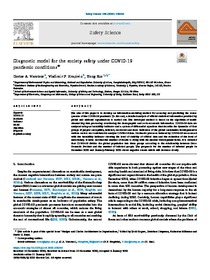Diagnostic model for the society safety under COVID-19 pandemic conditions

Varotsos, Costas A. ; Krapivin, Vladimir F. ; Xue, Yong
2021
136
April
1-6
epidemic disease ; prognosis ; safety management ; mathematical model
Occupational safety and health
https://doi.org/10.1016/j.ssci.2021.105164
English
Bibliogr.
"The aim of this paper is to develop an information-modeling method for assessing and predicting the consequences of the COVID-19 pandemic. To this end, a detailed analysis of official statistical information provided by global and national organizations is carried out. The developed method is based on the algorithm of multi-channel big data processing considering the demographic and socio-economic information. COVID-19 data are analyzed using an instability indicator and a system of differential equations that describe the dynamics of four groups of people: susceptible, infected, recovered and dead. Indicators of the global sustainable development in various sectors are considered to analyze COVID-19 data. Stochastic processes induced by COVID-19 are assessed with the instability indicator showing the level of stability of official data and the reduction of the level of uncertainty. It turns out that the number of deaths is rising with the Human Development Index. It is revealed that COVID-19 divides the global population into three groups according to the relationship between Gross Domestic Product and the number of infected people. The prognosis for the number of infected people in December 2020 and January-February 2021 shows negative events which will decrease slowly."
Digital
The ETUI is co-funded by the European Union. Views and opinions expressed are however those of the author(s) only and do not necessarily reflect those of the European Union or the ETUI.